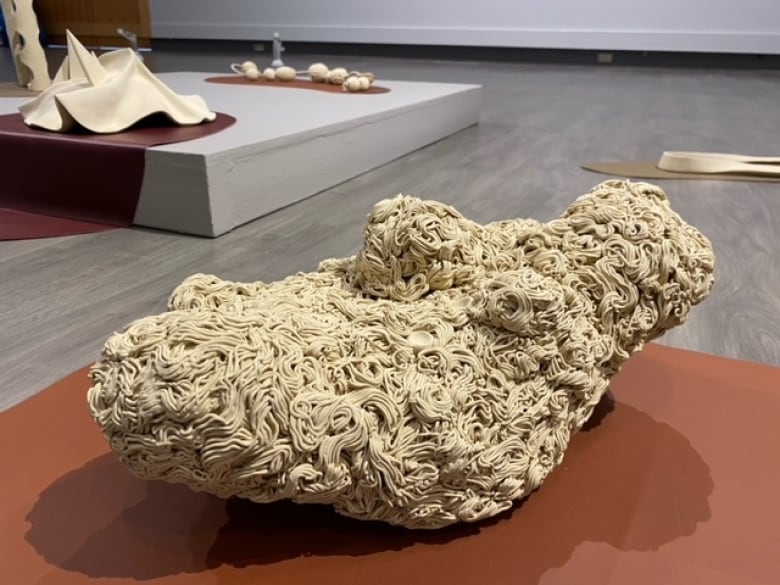We speak to the controversial Japanese artist about fetishism, his never-before displayed ‘hardcore’ paintings and Desire Machines – one of the inaugural exhibitions at the Museum of Sex opening soon in Miami
Despite the omnipresence of sex in our lives, we dedicate very little space and time to it – in public, at least. Of the estimated 104,000 museums across the world, just 20, as per my Wikipedia calculations, are currently devoted to the topic of sex and eroticism. Yes, there are sometimes exhibitions about sex, but a topic that’s so culturally significant, versatile, and that comes with an infinite history needs more than just a few rooms for a few weeks in a few temporary homes.
So, it’s always worth celebrating on the rare occasion that a new sex museum opens – and especially when it’s from an institution as formidable as the Museum of Sex. First opened in New York in 2002, the Museum of Sex has so far curated over 50 exhibitions that delve into human sexuality within the realms of art, science, and culture. And now, after two decades of success, it’s bringing all of this over to Miami, too.
“It’s super exciting for the institution to expand and open in Miami,” says Emily Shoyer, Museum of Sex’s curator-at-large. “Compared to New York, the space is much grander in scale and in spectacle.” Museum of Sex Miami’s inaugural program comprises three exhibitions. One is called Super Funland: Journey into the Erotic Carnival, and is a new iteration of its immersive, permanent, New York-based counterpart, which examines the sexual history of the carnival. Another is Modern Sex: 100 Years of Design and Decency, which surveys the cultural debates and societal impact of restriction on the design, marketing, and distribution of sexual health products from the 1920s until today. As Florida’s Supreme Court just approved the state’s six-week abortion ban – one of the strictest in America – the latter, as Shoyer puts it, “feels deeply important in Florida right now”. Also on the bill is Hajime Sorayama: Desire Machines, which explores the beauty and eroticism of human bodies and machines, and marks the legendary Japanese artist and illustrator’s first solo exhibition in the US.
If you haven’t already heard of Hajime Sorayama, the fashion girlies among you may have unwittingly come across his work via Dior. Specifically, via the fashion house’s AW19 men’s show, for which Sorayama created a giant robot pin-up sculpture (which was 11 metres tall and weighed over 9,000kg). These hyper-realistic android pin-ups or ‘sexy robots’ – with their gleaming but soft metal skins and exaggerated, hypersexualised female forms – are the artist’s signature aesthetic, and have been the focus of his career ever since he was first commissioned to draw one for a Japanese whiskey company back in 1978 (the brief was a sexy female character loosely based on Star Wars’ C-3PO). Shoyer say, “Our director Dan Gluck immediately thought of Sorayama for the inaugural Museum of Sex Miami exhibition because of his historic contributions to the field of erotic aesthetics and ongoing impact on popular culture.”



Hajime Sorayama, Untitled (2020) Acrylic on illustration board H51.5 x W72.8 cm©Hajime Sorayama Courtesy of NANZUKA
Desire Machines and Sorayama’s work more broadly – which has always been, and still is, ahead of its time – is particularly relevant now. Technosexuality is booming, with AI companion apps and sexting chatbots continuing to grow in popularity, and all of us are becoming cyborgs, of sorts, ourselves. Did Sorayama envision this future when he started his work in the late 70s? Can sexual fantasy, beauty, and eroticism ever be found in these mediums?
In a conversation over email, Sorayama tells Dazed that he’s “not interested in other people’s fetishism”. “All the context in my work is very physical,” he continues. “My robotic body paintings are soft like human skin. For those who want to have sex with AI, that’s their thing, not mine.”
To curate Desire Machines, the Museum of Sex worked closely with Nanzuka Gallery in Tokyo, which represents Sorayama. The exhibition comprises paintings and sculptures from Sorayama’s ‘sexy robot’ series, though Sorayama doesn’t do the sculpting himself. “My beloved studio assistants do it under my strict direction,” he explains. “But they’ve stopped showing me [mid-process], as I check every single detail and keep changing [things].”
“All the context in my work is very physical. My robotic body paintings are soft like human skin. For those who want to have sex with AI, that’s their thing, not mine” – Hajime Sorayama
He also, it seems, takes no nonsense. Responding to being asked why he particularly likes working with chrome and what he finds so bewitching and erotic about it, he says: “Your question is like, ‘Why do you like diamonds and gold?’ We’re creatures all the same. Fish and birds love light. We react automatically to things that shine.” He also reveals, “Nanzuka, my gallery, forces me to draw robots as it makes money,” he tells me when I ask what continues to draw him to his android pin-ups. “My family and Nanzuka are partners in crime behind my back.”
Among the other artworks, there will also be 20 of Sorayama’s never-before-seen paintings on display, chosen for their focus on the erotic relations between machines, humans, and animals. “I have quite a few hardcore sexy paintings, but my gallery has never put them on view until now,” says Sorayama. “Many of those in the Western academic art communities are too afraid of something erotic and sexy being misinterpreted by society as social ills. So they don’t show my erotic paintings, as they think it’s taboo. I find it hard to understand because everyone knows that sex is our fundamental protocol for birth and life.”



Hajime Sorayama installation shot, Museum of Sex Miami (2024)©Hajime Sorayama Courtesy of NANZUKA
Shoyer adds: “I appreciate how Sorayama’s work engenders discussions about the real and the fantastic, the erotic appeal of the inorganic, and the porous boundaries between being human, machine, and animal, especially in relation to subjectivity or myths of consent.” She says there’s one particular piece she wants to highlight – and one that ties the Museum of Sex Miami’s inaugural programme together nicely. “The painting [an untitled work painted by Sorayama in 2022] features a fembot using a vibrator,” she explains. “Gold halos hover over the robot’s head and the head of the vibrator, sanctifying both machines. The vibrator features a hand crank, referencing the early history of vibrators – a history that’s also on view in Modern Sex. Hand-cranked vibrating stimulatory machines were first invented during the industrial revolution. An object like the Vee Dee vibrator (1900-1915) features a similar hand-crank to the vibrator on view in Sorayama’s painting. As such, in this work, Sorayama seems to combine the early history of mechanical stimulators with a futuristic look at self-stimulation. Here, the past, present, and our visions for the future compound. The painting seems to ask, ‘How has erotic desire, self-stimulation, and the subjectivity of other-than-human figures manifested, and how will it play out going forward?’.”
By referencing the past in this way (see also his Marilyn Monroe android pin-up), Sorayama imbues his ‘sexy robots’ – who he refers to as his wives and daughters – with a past. They’re simultaneously human, with realistic, supple flesh and familiar histories, and yet disorientingly non-human, futuristic, and fantastical. At a time when we have more tools than ever than envision a different kind of eroticism – and yet people use AI to reinforce the same Western ideals of sexiness – Sorayama remains one of the few still really pushing the boundaries of what eroticism can look like. “I’m excited and very proud of how [Desire Machines] came together,” he concludes. “I can’t wait to see the viewers’ reaction. I just need to keep behaving myself so I won’t get arrested before the show starts.”
Visit the gallery above for a closer look at some of the artwork going on display at the Musuem of Sex in Miami.
Museum of Sex Miami opens in 2024. Follow their Instagram for updates.























